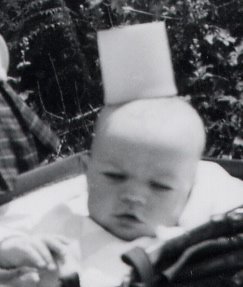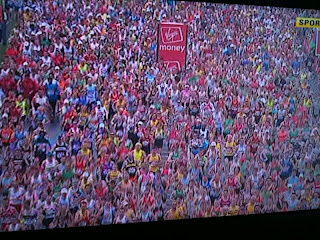Update: some good photos here.
"A word on the spot is worth a cartload of recollections"
James Maggs, Southwold diarist 1797-1890
Sunday, 25 April 2010
Poverty map of London

Via Jane's London I've just discovered Charles Booth's online archive. His poverty map of London gives a fascinating insight into how London has changed since the end of the nineteenth century.
Wednesday, 21 April 2010
No time
What is this life if, full of care,
We have no time to stand and stare.
No time to stand beneath the boughs
And stare as long as sheep or cows.
No time to see, when woods we pass,
Where squirrels hide their nuts in grass.
No time to see, in broad daylight,
Streams full of stars, like skies at night.
No time to turn at Beauty's glance,
And watch her feet, how they can dance.
No time to wait till her mouth can
Enrich that smile her eyes began.
A poor life this if, full of care,
We have no time to stand and stare.
"Leisure", by Wm. Henry Davies.
We have no time to stand and stare.
No time to stand beneath the boughs
And stare as long as sheep or cows.
No time to see, when woods we pass,
Where squirrels hide their nuts in grass.
No time to see, in broad daylight,
Streams full of stars, like skies at night.
No time to turn at Beauty's glance,
And watch her feet, how they can dance.
No time to wait till her mouth can
Enrich that smile her eyes began.
A poor life this if, full of care,
We have no time to stand and stare.
"Leisure", by Wm. Henry Davies.
Sunday, 11 April 2010
Gogarth
 We're just back from a weekend climbing on the Gogarth sea cliffs, on Holy Island (just off Anglesey).
We're just back from a weekend climbing on the Gogarth sea cliffs, on Holy Island (just off Anglesey). On Saturday morning, as Nick and I approached the massive cliffs, I was having doubts about whether we'd made the best choice of venue for our first rock trip of 2010. After a few months' gap I'm always jittery getting back on rock. And Gogarth
On Saturday morning, as Nick and I approached the massive cliffs, I was having doubts about whether we'd made the best choice of venue for our first rock trip of 2010. After a few months' gap I'm always jittery getting back on rock. And Gogarthcan make you feel "gripped" at the best of times.

For some reason though this weekend, Gogarth felt almost friendly: warm sun shone both days and there was little wind. There was no big swell or waves booming in the zawns. Instead, seals watched us from the sea as we climbed. Oystercatchers piped, the first bumblebees of the year buzzed around, and puffins flew in formation above the calm surface below.
I started on The Gauntlet, soon relaxing into the climbing. The quartzite rock at Gogarth is a pleasure to climb on: hard, angular and positive. Nick then led The Ramp, running the 2 pitches into one, and suffering bad rope drag. We then climbed the Puffin Direct/Force 8 combination, the first pitch of which was quite strenuous. I was happy to get up it without resting on gear.

Today we climbed Gogarth, E1 5B, the original route up the Main Wall. The first four pitches gave excellent, varied climbing. The final pitch was hard and we struggled up it in poor style.
It was an weekend of fine climbing in warm sunshine, with Gogarth feeling friendly for once. 3 HVS and an E1 - not bad for our first weekend back on the rock.
Tuesday, 6 April 2010
Photos on UKClimbing
There are some superb photos on the UK Climbing website.
One of my favourites is this one of Ueli Steck flying up the Supercouloir. The darkness below makes it look like he is climbing above a void, deepening the sense of vertigo. Judging by how far Steck has climbed before placing a runner (protection in case of a fall) Steck seems oblivious to the exposure.
Monday, 5 April 2010
Burma, then and now
As a teenager I was lucky enough to spend a few months in Burma during 1980. That was before Aung San Suu Kyi was put under house arrest and before the regime in Burma became a pariah state. At that time the only English language newspaper available was the Rangoon Working People's Daily, which was little more than a laughably dull list of the activities of government officials. I laughed, but at the time I was too young to understand.
Since then things have worsened. The government's refusal to recognise the outcome of national elections was followed last year by further crackdowns on street protests, widescale round-ups and imprisonment of dissenters. At around the same time a Burmese blogger was sentenced to 59 years in prison for posting up video footage following Cyclone Nargis. Burma heads the Committee to Protect Journalists' list of worst countries to be a Blogger.
On 10 March this year a UN report called for an investigation into whether the generals running the country are guilty of war crimes against their own people. I do wonder whether the threat of war crimes tribunals may be counterproductive, helping to dissuade the generals from any relaxation of their grip on power, encouraging them instead to dig in further. Then again it may be naive to suppose that they would ever give up power voluntarily. There are indications already that this autumn's elections will be a sham.
Looking back to earlier and happier times, Wendy Law-Yone has written an interesting article in the Guardian about her childhood memories of her father's pioneering editorship of the old Rangoon Nation newspaper, prior to the 1962 coup. Once it carried a headline:
Burma has only twenty dentists but every Tom Dick and Harry is pulling teeth, Rotarian says
I can't imagine such a headline ever appeared in the Working People's Daily.
Update 14 May: Simon Tisdall has written an interesting review of the state of Obama's policy of "positive engagement" with Burma.
Sunday, 4 April 2010
Two old photos
 I love these two old photographs. They aren't brilliant technically (they're just snaps) but I love them nonetheless. I found them in a box of negatives belonging to my cousin Joan, who died aged 85 in 1998. From other photos in the box it's clear they were taken in 1918 or 1919. They seem much more modern than that, at least in part because of the natural and informal pose of the subject (I think both photos are of the same woman, captured in strikingly different moods).
I love these two old photographs. They aren't brilliant technically (they're just snaps) but I love them nonetheless. I found them in a box of negatives belonging to my cousin Joan, who died aged 85 in 1998. From other photos in the box it's clear they were taken in 1918 or 1919. They seem much more modern than that, at least in part because of the natural and informal pose of the subject (I think both photos are of the same woman, captured in strikingly different moods). She seems pretty in a modern way, too, somehow.
She must have been a relation or a friend of the family. In the second photo she's sitting on the Richards' family boat. But we don't know who she was.
Archie's postcards

In 1903, 5 year old Archie Emms (my maternal grandfather-to-be) was busy building a collection of postcards of Lowestoft, the Suffolk coastal town in which he lived.
Present-day Lowestoft is a quiet place, but back in 1903 it was a busy Edwardian seaside resort.

It was also a thriving fishing port, from which hundreds of fishing smacks worked the North Sea for herring.

Like Covehithe 10 miles to the south, Lowestoft was then under constant attack by the sea. Many of Archie's postcards show this.







I wonder what went through Archie's mind as he looked at these images. They must at least have helped to keep boredom at bay. Edwardian Sundays can't have been much fun for a 5 year old.


Thursday, 1 April 2010
The Evil Weed
 At school my housemaster called tobacco "the Evil Weed". He was dead right of course. I thought I knew better though, as teenagers do, and so I saddled myself with an addiction that's been with me ever since.
At school my housemaster called tobacco "the Evil Weed". He was dead right of course. I thought I knew better though, as teenagers do, and so I saddled myself with an addiction that's been with me ever since.I've stopped a few times. In the last few years I've become a bit of an expert on Giving Up Smoking. In fact I've got it down pat. My problem is STAYING a non-smoker.
Anyway, from tonight I'm going to start another "break" from the Evil Weed, and this time it's public. Let's see how it goes.
Subscribe to:
Posts (Atom)



